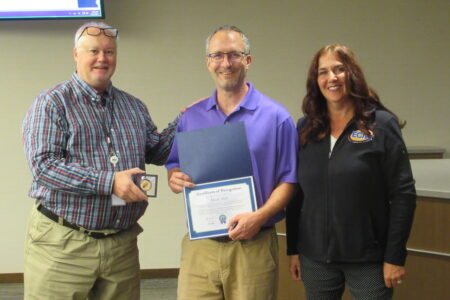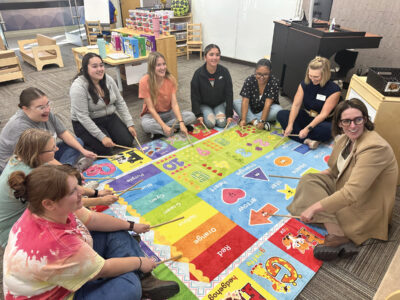Marshall school officials say budget struggles statewide
MARSHALL — Marshall Public School officials held an informational session hosted by the chamber Wednesday afternoon to further discuss the upcoming voter-led $2 million, 10-year operating referendum. A few community members brought up questions regarding enrollment, tax impact and classroom sizes.
The district is pursuing the referendum due to facing a $1.8 million deficit for this school year, after coming off a $1.1 million deficit last school year, which is expected to continue to grow in the coming years.
The school board recently approved that district administration make a near-$2 million budget cut beginning next year if the referendum does not pass, which includes a series of staff positions and elimination of programs.
A significant reason the district is facing a shortfall is due to the state’s general education formula trailing the rate of inflation over the years.
“We’re not alone in our current financial situation. These struggles are statewide,” MPS Director of Finance Sarah Kirchner said. “Many districts are really struggling with a lot of tough decisions financially right now, and one of the most impactful factors that we’re seeing as an issue, is our state funding really isn’t keeping up with the inflation rate from year-to-year.”
With data from the Minnesota Department of Education going back to 2003, in a presentation shown by Kirchner and superintendent Jeremy Williams, “The difference between the Fiscal Year 2026 formula allowance per pupil and the (state’s) inflation adjusted formula allowance is $1,420.”
For 2025, the graph showed that if the general education formula kept pace with inflation, the district would be getting an allowance of $8,901 per pupil, but instead receives $7,481 per pupil.
“Back in 2003 they were in line, and slowly over the years, and especially really in the last five years, that gap has grown pretty significantly,” Kirchner said.
Community questions
After hearing that the 2023-2024 and 2024-2025 school year had more students open-enrolling out of the district than in, one community question was asked deeper as to why that is.
Williams attributed that due to there previously not being an online school option with MPS, which they have since added.
“One thing we’ve done to try to prevent students from enrolling out of our district is we now offer an online option through Marshall Public Schools for our resident students,” Williams said. “So, if they’re thinking about potentially going to a different district or finding a different online program, we can offer online in our district now to those students to prevent them, hopefully, from leaving.”
Williams noted the online-schooling option is being used and the district has around 20 students currently utilizing it, and there has since been a drop in number of students openly enrolling out of the district last year.
In 2023-24, there were 33 students that open enrolled out of MPS, and there were 21 in 2024-25. There was a positive difference of 28 students from other districts that enrolled into MPS in the 2022-23 school year, and 37 in 2021-22.
Enrollment is another area that drives in revenue, which MPS is projecting a drop in, due to smaller class sizes coming in.
“Enrollment also plays another pretty big factor in a lot of our funding. It drives that general-ed funding formula,” Kirchner said. “Looking at our kindergartners, because that’s really what we use to drive what we’re projecting each year, is what we have for incoming kindergarteners. If you compare the 2015-16 school year, we had 185 kindergartners coming in. Last year, we had about 162 … I just looked at our enrollment spreadsheet that we keep track of on a weekly basis, and we’re at 158 total kindergartens right now.”
Williams and Kirchner were also asked about the reality of what classroom impacts would be.
“The lowest elementary (class is about) 18 to 19 (students). You get to upper elementary, 20, 21, maybe 22 in a classroom. I would say that on average, classes would go up about 20% per room. It all depends on that grade level,” Williams said. “The smallest grades are where we (would) make the cuts to try to minimize bigger class sizes as much as we can.”
The proposed cuts to take place next school year that the board approved, upon a failed referendum, includes 29 staff positions across the district, the elimination of some career-prep classes in middle and high school, program cuts, and eliminating bus routes in a 1-mile radius of Southview and Park Side Elementary. A final list of reductions will be presented to the board no later than February 2, 2026 if the vote fails.
There also was a question regarding specifically what tax impacts will look like.
A home valued at $225,000 would see an increase of around $26 a month. The referendum, if passed, will be for 10 years with the option to renew once.
Tax impact applies to homesteads, commercial and industrial property and agricultural homes including a garage and one acre of surrounding land.
All other agricultural land and seasonal properties will not see a tax impact.
Community members may also be eligible for tax credits such as the Minnesota Homestead Credit Refund, Special Property Tax Refund and the Senior Citizen Property Tax Deferral.
Voting information
All referendum information can be found at www.tomorrowstigers.org, or community members can contact Williams or Kirchner with questions.
With less than a month left until the special election, early voting is currently open at the district office from 8 a.m. to 4:30 p.m. Monday through Friday. The district office is located on the backside of the middle school.
Election day is Tuesday, Nov. 4, at the middle school from 7 a.m. to 8 p.m.



